HC1010: Financial Statement Analysis - Accounting for Business
VerifiedAdded on 2023/03/23
|6
|1206
|37
Homework Assignment
AI Summary
This assignment solution for an Accounting for Business course (HC1010) provides a detailed analysis of financial statements, focusing on ratio analysis, liquidity, and operational efficiency. It evaluates a company's ability to meet short-term liabilities using current and quick ratios, and assesses operational efficiency through accounts receivable and inventory turnover. The solution also addresses revenue recognition in accordance with AASB 118, categorizing various cash inflows for Green Apple Ltd. Furthermore, it compares two companies (ABC and XYZ) based on their financial health, capital structure, and debt liabilities to determine investment preferences. Desklib offers a wide range of study resources, including past papers and solved assignments, to support students in their academic endeavors.
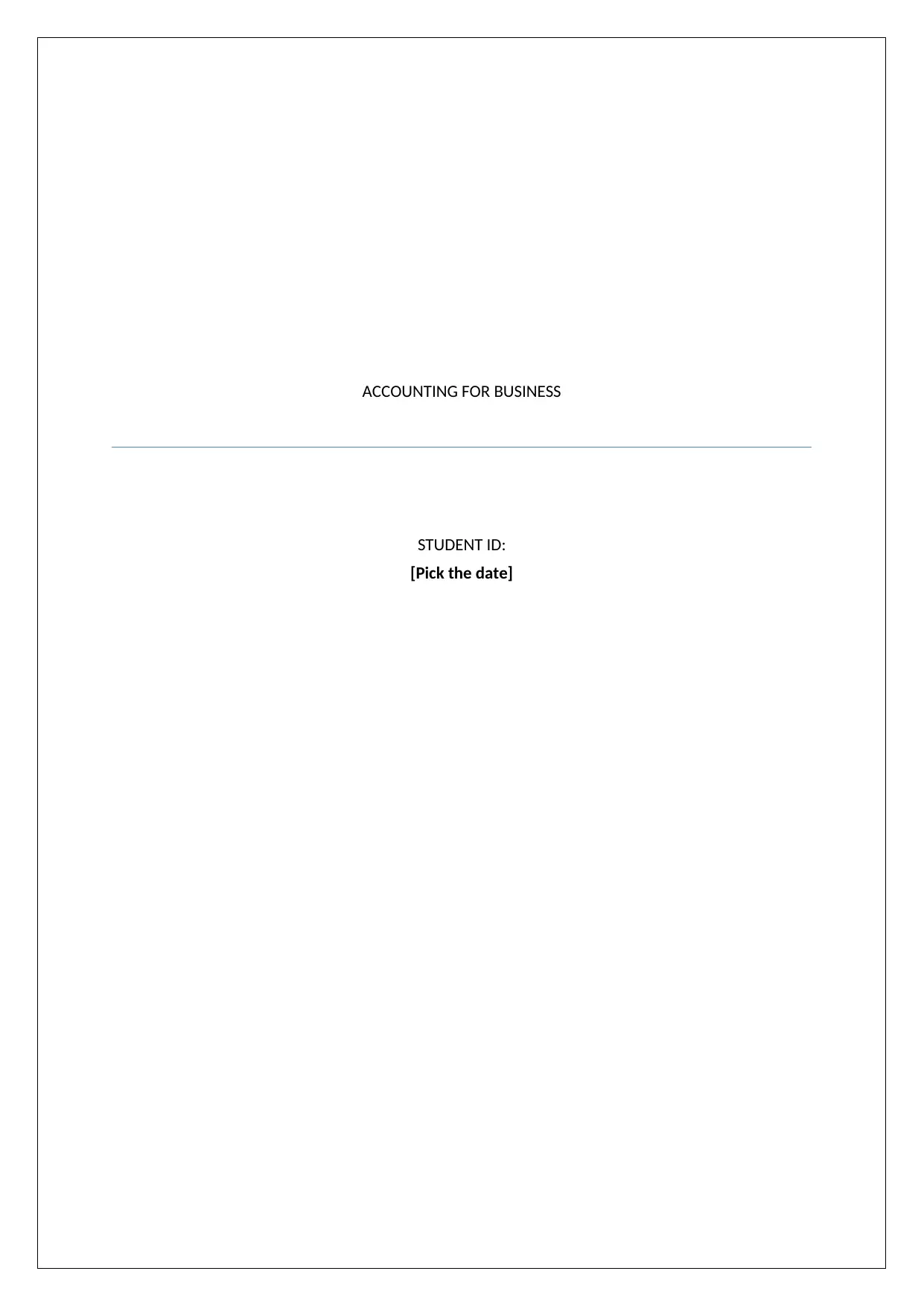
ACCOUNTING FOR BUSINESS
STUDENT ID:
[Pick the date]
STUDENT ID:
[Pick the date]
Paraphrase This Document
Need a fresh take? Get an instant paraphrase of this document with our AI Paraphraser
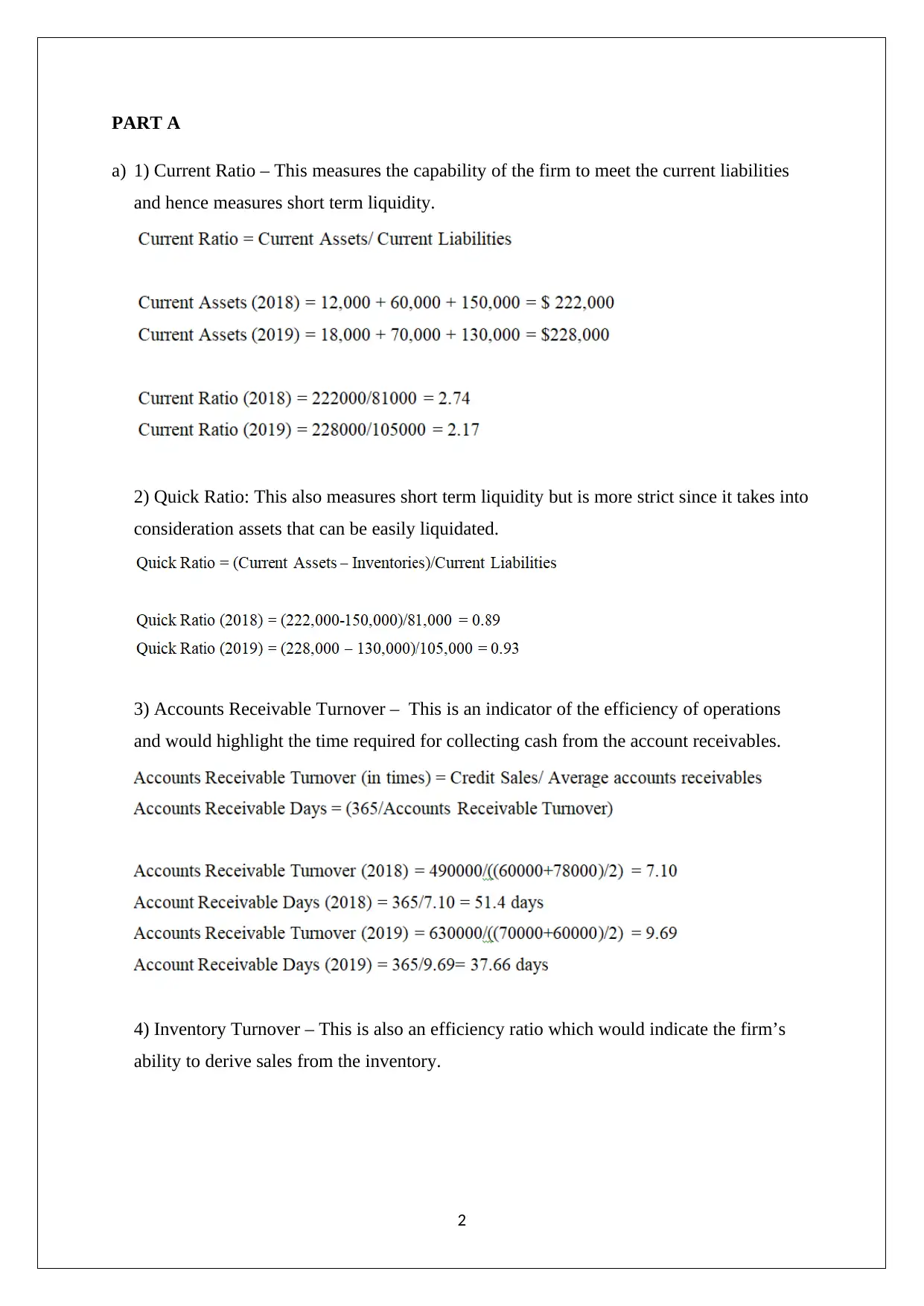
PART A
a) 1) Current Ratio – This measures the capability of the firm to meet the current liabilities
and hence measures short term liquidity.
2) Quick Ratio: This also measures short term liquidity but is more strict since it takes into
consideration assets that can be easily liquidated.
3) Accounts Receivable Turnover – This is an indicator of the efficiency of operations
and would highlight the time required for collecting cash from the account receivables.
4) Inventory Turnover – This is also an efficiency ratio which would indicate the firm’s
ability to derive sales from the inventory.
2
a) 1) Current Ratio – This measures the capability of the firm to meet the current liabilities
and hence measures short term liquidity.
2) Quick Ratio: This also measures short term liquidity but is more strict since it takes into
consideration assets that can be easily liquidated.
3) Accounts Receivable Turnover – This is an indicator of the efficiency of operations
and would highlight the time required for collecting cash from the account receivables.
4) Inventory Turnover – This is also an efficiency ratio which would indicate the firm’s
ability to derive sales from the inventory.
2
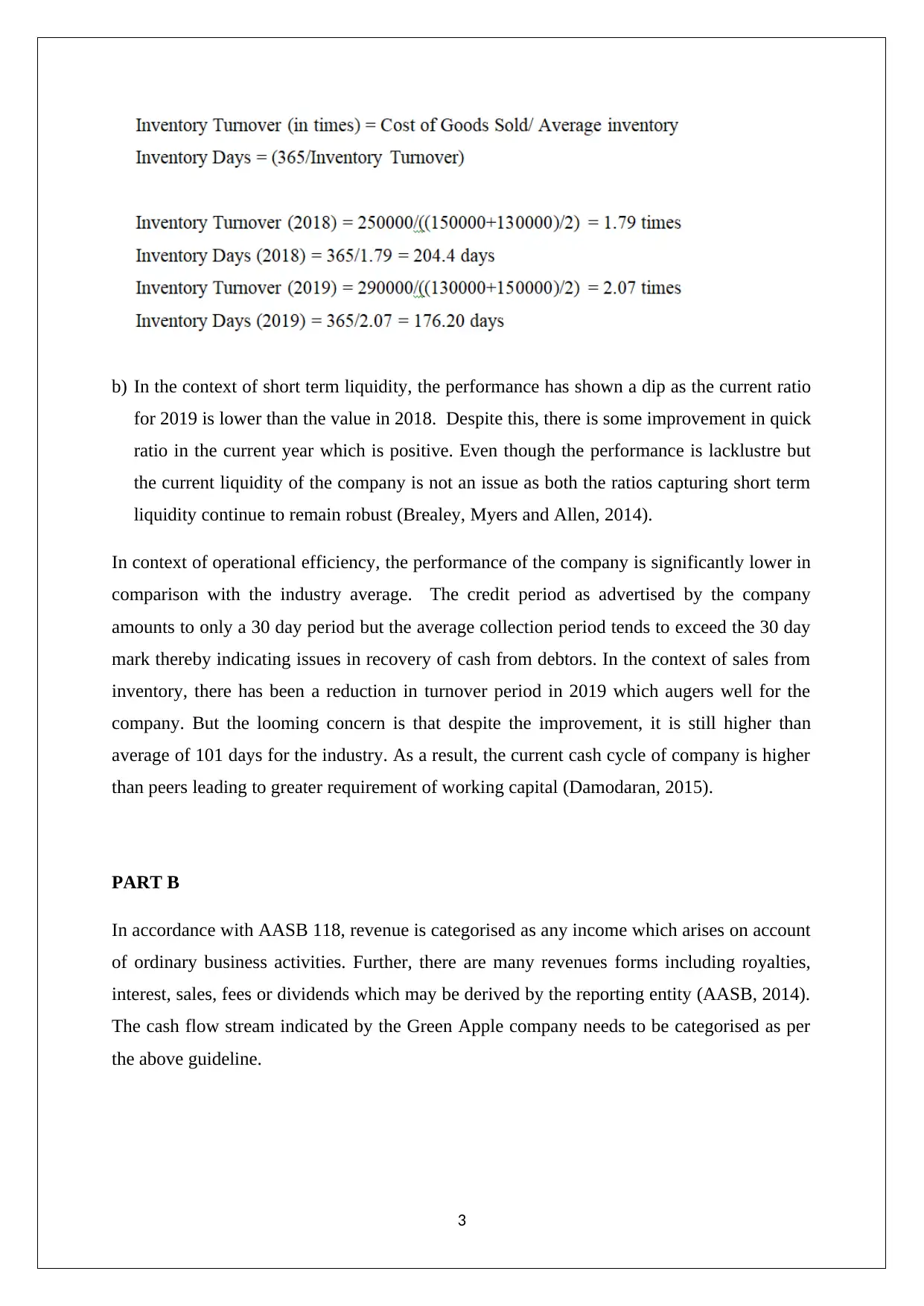
b) In the context of short term liquidity, the performance has shown a dip as the current ratio
for 2019 is lower than the value in 2018. Despite this, there is some improvement in quick
ratio in the current year which is positive. Even though the performance is lacklustre but
the current liquidity of the company is not an issue as both the ratios capturing short term
liquidity continue to remain robust (Brealey, Myers and Allen, 2014).
In context of operational efficiency, the performance of the company is significantly lower in
comparison with the industry average. The credit period as advertised by the company
amounts to only a 30 day period but the average collection period tends to exceed the 30 day
mark thereby indicating issues in recovery of cash from debtors. In the context of sales from
inventory, there has been a reduction in turnover period in 2019 which augers well for the
company. But the looming concern is that despite the improvement, it is still higher than
average of 101 days for the industry. As a result, the current cash cycle of company is higher
than peers leading to greater requirement of working capital (Damodaran, 2015).
PART B
In accordance with AASB 118, revenue is categorised as any income which arises on account
of ordinary business activities. Further, there are many revenues forms including royalties,
interest, sales, fees or dividends which may be derived by the reporting entity (AASB, 2014).
The cash flow stream indicated by the Green Apple company needs to be categorised as per
the above guideline.
3
for 2019 is lower than the value in 2018. Despite this, there is some improvement in quick
ratio in the current year which is positive. Even though the performance is lacklustre but
the current liquidity of the company is not an issue as both the ratios capturing short term
liquidity continue to remain robust (Brealey, Myers and Allen, 2014).
In context of operational efficiency, the performance of the company is significantly lower in
comparison with the industry average. The credit period as advertised by the company
amounts to only a 30 day period but the average collection period tends to exceed the 30 day
mark thereby indicating issues in recovery of cash from debtors. In the context of sales from
inventory, there has been a reduction in turnover period in 2019 which augers well for the
company. But the looming concern is that despite the improvement, it is still higher than
average of 101 days for the industry. As a result, the current cash cycle of company is higher
than peers leading to greater requirement of working capital (Damodaran, 2015).
PART B
In accordance with AASB 118, revenue is categorised as any income which arises on account
of ordinary business activities. Further, there are many revenues forms including royalties,
interest, sales, fees or dividends which may be derived by the reporting entity (AASB, 2014).
The cash flow stream indicated by the Green Apple company needs to be categorised as per
the above guideline.
3
⊘ This is a preview!⊘
Do you want full access?
Subscribe today to unlock all pages.

Trusted by 1+ million students worldwide
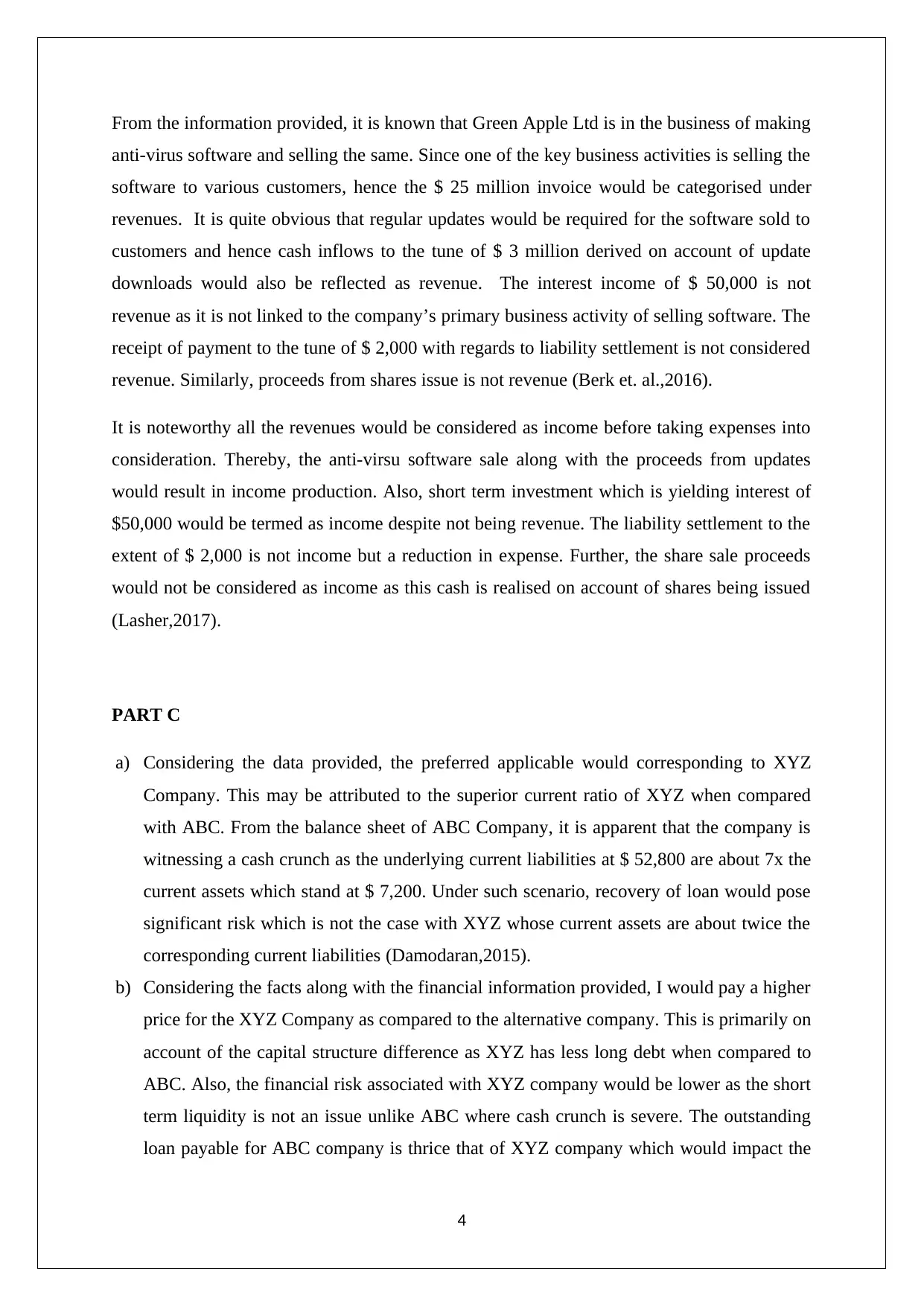
From the information provided, it is known that Green Apple Ltd is in the business of making
anti-virus software and selling the same. Since one of the key business activities is selling the
software to various customers, hence the $ 25 million invoice would be categorised under
revenues. It is quite obvious that regular updates would be required for the software sold to
customers and hence cash inflows to the tune of $ 3 million derived on account of update
downloads would also be reflected as revenue. The interest income of $ 50,000 is not
revenue as it is not linked to the company’s primary business activity of selling software. The
receipt of payment to the tune of $ 2,000 with regards to liability settlement is not considered
revenue. Similarly, proceeds from shares issue is not revenue (Berk et. al.,2016).
It is noteworthy all the revenues would be considered as income before taking expenses into
consideration. Thereby, the anti-virsu software sale along with the proceeds from updates
would result in income production. Also, short term investment which is yielding interest of
$50,000 would be termed as income despite not being revenue. The liability settlement to the
extent of $ 2,000 is not income but a reduction in expense. Further, the share sale proceeds
would not be considered as income as this cash is realised on account of shares being issued
(Lasher,2017).
PART C
a) Considering the data provided, the preferred applicable would corresponding to XYZ
Company. This may be attributed to the superior current ratio of XYZ when compared
with ABC. From the balance sheet of ABC Company, it is apparent that the company is
witnessing a cash crunch as the underlying current liabilities at $ 52,800 are about 7x the
current assets which stand at $ 7,200. Under such scenario, recovery of loan would pose
significant risk which is not the case with XYZ whose current assets are about twice the
corresponding current liabilities (Damodaran,2015).
b) Considering the facts along with the financial information provided, I would pay a higher
price for the XYZ Company as compared to the alternative company. This is primarily on
account of the capital structure difference as XYZ has less long debt when compared to
ABC. Also, the financial risk associated with XYZ company would be lower as the short
term liquidity is not an issue unlike ABC where cash crunch is severe. The outstanding
loan payable for ABC company is thrice that of XYZ company which would impact the
4
anti-virus software and selling the same. Since one of the key business activities is selling the
software to various customers, hence the $ 25 million invoice would be categorised under
revenues. It is quite obvious that regular updates would be required for the software sold to
customers and hence cash inflows to the tune of $ 3 million derived on account of update
downloads would also be reflected as revenue. The interest income of $ 50,000 is not
revenue as it is not linked to the company’s primary business activity of selling software. The
receipt of payment to the tune of $ 2,000 with regards to liability settlement is not considered
revenue. Similarly, proceeds from shares issue is not revenue (Berk et. al.,2016).
It is noteworthy all the revenues would be considered as income before taking expenses into
consideration. Thereby, the anti-virsu software sale along with the proceeds from updates
would result in income production. Also, short term investment which is yielding interest of
$50,000 would be termed as income despite not being revenue. The liability settlement to the
extent of $ 2,000 is not income but a reduction in expense. Further, the share sale proceeds
would not be considered as income as this cash is realised on account of shares being issued
(Lasher,2017).
PART C
a) Considering the data provided, the preferred applicable would corresponding to XYZ
Company. This may be attributed to the superior current ratio of XYZ when compared
with ABC. From the balance sheet of ABC Company, it is apparent that the company is
witnessing a cash crunch as the underlying current liabilities at $ 52,800 are about 7x the
current assets which stand at $ 7,200. Under such scenario, recovery of loan would pose
significant risk which is not the case with XYZ whose current assets are about twice the
corresponding current liabilities (Damodaran,2015).
b) Considering the facts along with the financial information provided, I would pay a higher
price for the XYZ Company as compared to the alternative company. This is primarily on
account of the capital structure difference as XYZ has less long debt when compared to
ABC. Also, the financial risk associated with XYZ company would be lower as the short
term liquidity is not an issue unlike ABC where cash crunch is severe. The outstanding
loan payable for ABC company is thrice that of XYZ company which would impact the
4
Paraphrase This Document
Need a fresh take? Get an instant paraphrase of this document with our AI Paraphraser
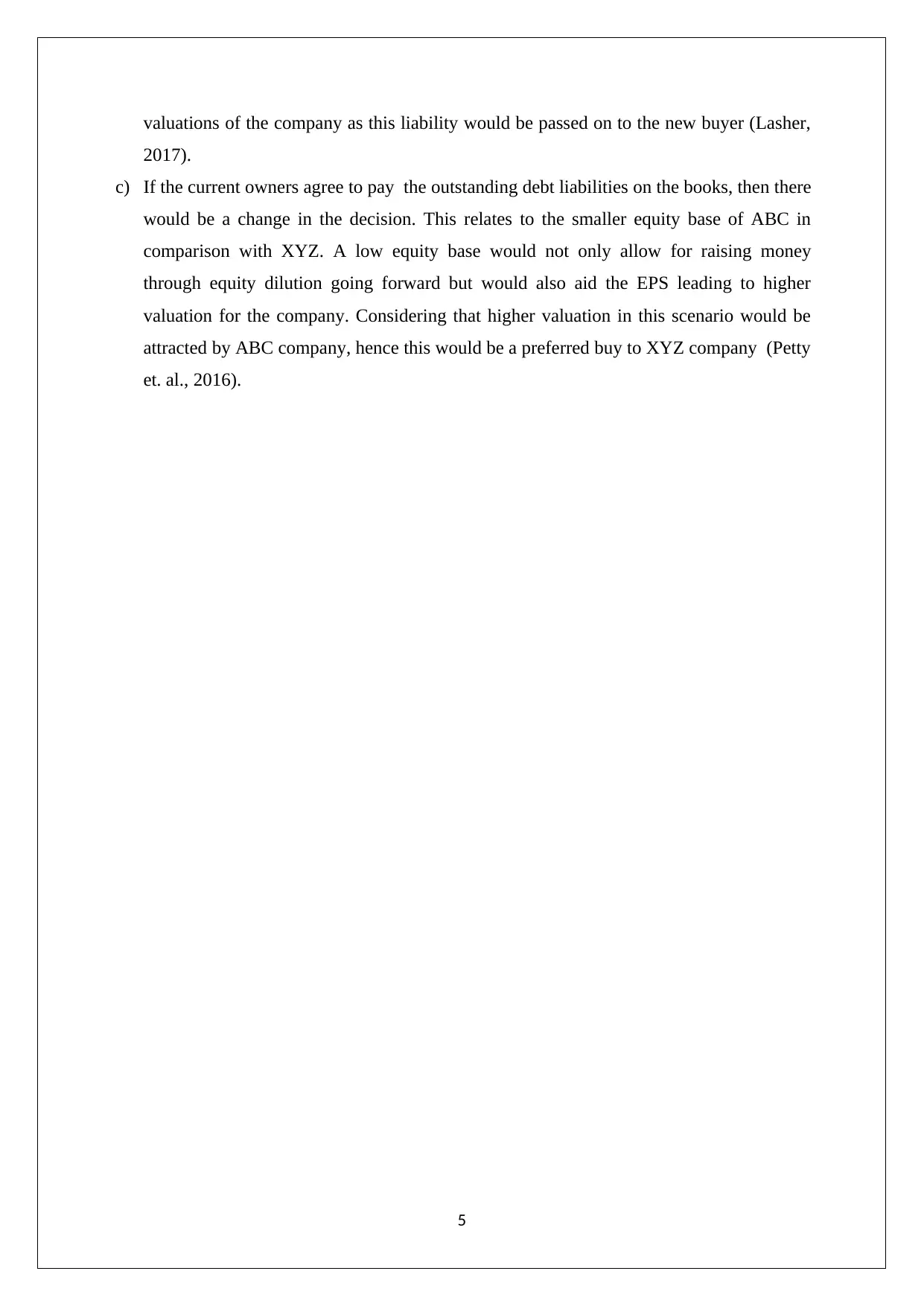
valuations of the company as this liability would be passed on to the new buyer (Lasher,
2017).
c) If the current owners agree to pay the outstanding debt liabilities on the books, then there
would be a change in the decision. This relates to the smaller equity base of ABC in
comparison with XYZ. A low equity base would not only allow for raising money
through equity dilution going forward but would also aid the EPS leading to higher
valuation for the company. Considering that higher valuation in this scenario would be
attracted by ABC company, hence this would be a preferred buy to XYZ company (Petty
et. al., 2016).
5
2017).
c) If the current owners agree to pay the outstanding debt liabilities on the books, then there
would be a change in the decision. This relates to the smaller equity base of ABC in
comparison with XYZ. A low equity base would not only allow for raising money
through equity dilution going forward but would also aid the EPS leading to higher
valuation for the company. Considering that higher valuation in this scenario would be
attracted by ABC company, hence this would be a preferred buy to XYZ company (Petty
et. al., 2016).
5
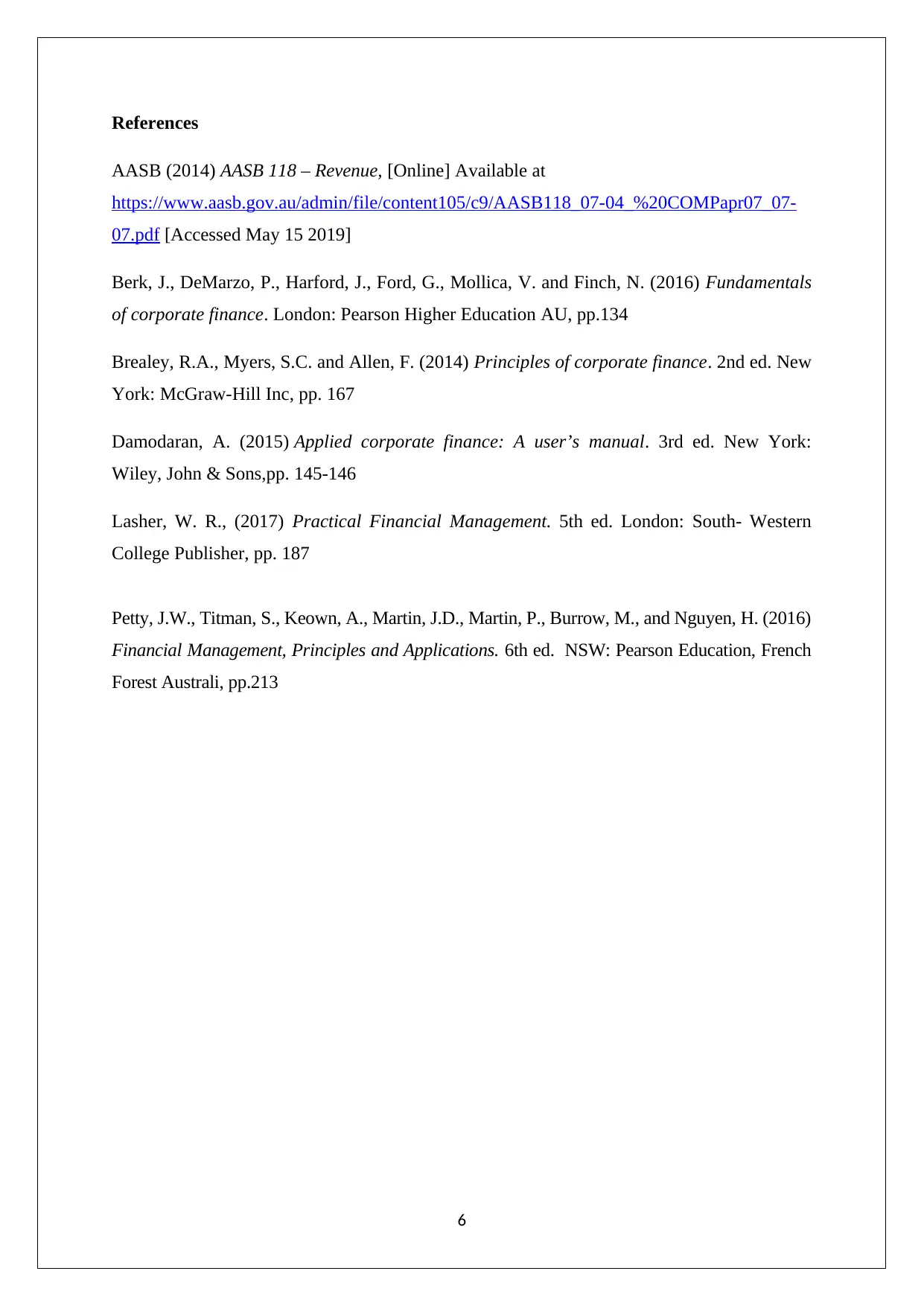
References
AASB (2014) AASB 118 – Revenue, [Online] Available at
https://www.aasb.gov.au/admin/file/content105/c9/AASB118_07-04_%20COMPapr07_07-
07.pdf [Accessed May 15 2019]
Berk, J., DeMarzo, P., Harford, J., Ford, G., Mollica, V. and Finch, N. (2016) Fundamentals
of corporate finance. London: Pearson Higher Education AU, pp.134
Brealey, R.A., Myers, S.C. and Allen, F. (2014) Principles of corporate finance. 2nd ed. New
York: McGraw-Hill Inc, pp. 167
Damodaran, A. (2015) Applied corporate finance: A user’s manual. 3rd ed. New York:
Wiley, John & Sons,pp. 145-146
Lasher, W. R., (2017) Practical Financial Management. 5th ed. London: South- Western
College Publisher, pp. 187
Petty, J.W., Titman, S., Keown, A., Martin, J.D., Martin, P., Burrow, M., and Nguyen, H. (2016)
Financial Management, Principles and Applications. 6th ed. NSW: Pearson Education, French
Forest Australi, pp.213
6
AASB (2014) AASB 118 – Revenue, [Online] Available at
https://www.aasb.gov.au/admin/file/content105/c9/AASB118_07-04_%20COMPapr07_07-
07.pdf [Accessed May 15 2019]
Berk, J., DeMarzo, P., Harford, J., Ford, G., Mollica, V. and Finch, N. (2016) Fundamentals
of corporate finance. London: Pearson Higher Education AU, pp.134
Brealey, R.A., Myers, S.C. and Allen, F. (2014) Principles of corporate finance. 2nd ed. New
York: McGraw-Hill Inc, pp. 167
Damodaran, A. (2015) Applied corporate finance: A user’s manual. 3rd ed. New York:
Wiley, John & Sons,pp. 145-146
Lasher, W. R., (2017) Practical Financial Management. 5th ed. London: South- Western
College Publisher, pp. 187
Petty, J.W., Titman, S., Keown, A., Martin, J.D., Martin, P., Burrow, M., and Nguyen, H. (2016)
Financial Management, Principles and Applications. 6th ed. NSW: Pearson Education, French
Forest Australi, pp.213
6
⊘ This is a preview!⊘
Do you want full access?
Subscribe today to unlock all pages.

Trusted by 1+ million students worldwide
1 out of 6
Related Documents
Your All-in-One AI-Powered Toolkit for Academic Success.
+13062052269
info@desklib.com
Available 24*7 on WhatsApp / Email
![[object Object]](/_next/static/media/star-bottom.7253800d.svg)
Unlock your academic potential
Copyright © 2020–2025 A2Z Services. All Rights Reserved. Developed and managed by ZUCOL.





